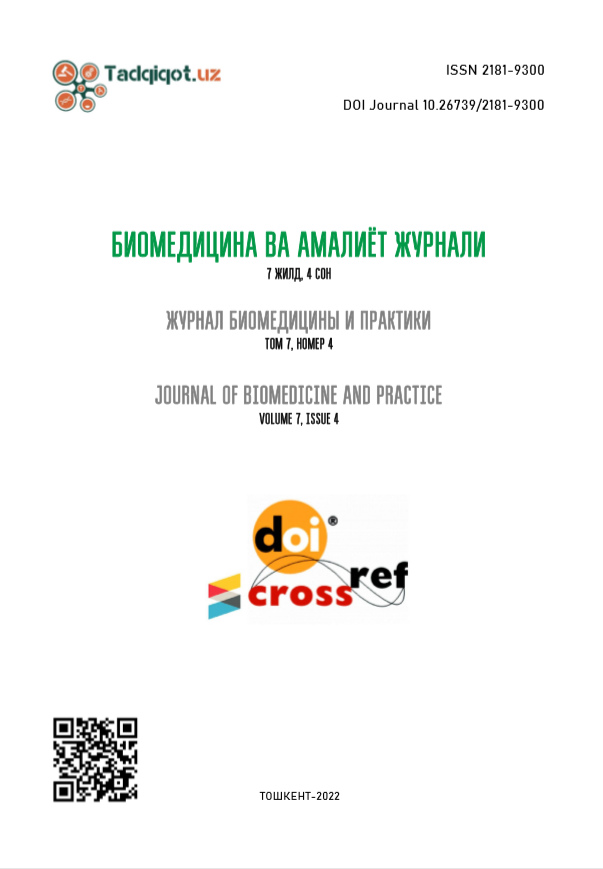THE SEVERITY OF HEALTH CAUSE IN CHILDREN WITH BLUNT INJURIES OF THE EYEBALL AND ITS ADDITIONS
Keywords:
eyeball, appendages, blunt injuries, criteria, severityAbstract
Objective: to identify criteria for forensic medical assessment of the severity of harm in case of blunt mechanical damage to the structures of the eyeball and its appendages in children.
Methods: the data of medical records and the results of additional studies were studied in relation to 56 sick children who received damage to the organ of vision (OS) with various types of blunt trauma.
Results: it was found that among children, the largest number of OA injuries is observed in the age group from 4 to 17 years (48 out of 56 cases) and mostly boys, which is associated with their more active behavior. The circumstances of the origin of the trauma of the OZ were: in children under 3 years old - accidents caused by the impact of various sharp or pointed blunt objects; and in children aged 4 to 7 years, injuries occurred mainly during games, as well as due to the negligence of children when handling various objects and in some cases - when falling; at the same time, in older children (8-17 years old), injuries were received during a quarrel with peers or in various sports games. Based on the nature and complications of injuries of the eyeball and its appendages, the qualifying criteria for forensic medical assessment of the degree of harm children had - the duration of health disorders, the volume of permanent loss of general ability to work, as well as the loss of an organ (with blindness in both eyes), in addition, in some cases there were signs of cosmetic disorders associated with anophthalmos and subatrophy of the eyeball.
Conclusions: the revealed damages in the structures of the eyeball and its appendages in children in accordance with the specified criteria were qualified: to the category of light bodily injuries (12.5%); to the category of medium degree (82.1%); to the category of grievous bodily harm (5.4%). The predominance of the average degree of injury was due to the anatomical and physiological characteristics of these structures in children.
References
Адейинка О. Травмы глаз у детей и подростков: отчет о 205 случаях. Журнал Национальной Медицинской Ассоциации. № 1. 2009. С. 51-56
Анн-Мари Э., Ярдли ФРАНЦКО, Мофт Аннетт К., Хоскин Бакалавр (Optom), MBA Кейт Hanman Борт, OphthalSc Сью Л., Ван MBBS, FRANZCO Дэвид А., Макки MD, FRANZCO Повреждения глаз и придатков у детей от животных: систематический обзор. Survey of Ophthalmology Volume 60. Issue 6. 2015. С. 536-546.
Бесланеева М.Б. Антиоксидантная терапия внутриглазных кровоизлияний при травмах глаз у детей. Автореферат диссертации канд. мед. наук. Москва. 2010. С. 51-52
Волков В.В. Открытая травма глаза. Монография. 2016. 280 с.
Волков В.В. Судебно-медицинская экспертиза травмы глаза. Судебно-медицинская экспертиза. 2010. № 6. С. 42-43
Григорьева Е.Н. Судебно-медицинская оценка тяжести вреда здоровью при переломах костей скулоорбитального комплекса, автореферат диссертации на соискание ученой степени кандидата медицинских наук. Москва. 2012. С. 42-43
Гундорова Р.А., Кашников В.В. Монография. Повреждения глаз в чрезвычайных ситуациях. 2002. С. 137-141
Гундорова Р.А., Нероев В.В., Кашников В.В. Травмы глаз. М. 2009. С. 553
Ермолаев В.Г. Эпидемиология глазного травматизма. Астрахань. 2003. 310 с.
Капелюшникова Н.И. Лазеры в лечении отслойки сосудистой оболочки после механической травмы глазного яблока. Дисс. канд. мед. наук. Москва. 2003. 121 с.
Ксинтонг Ли, Марко А. Зарбин. Отделение офтальмологии Нилакши Бхагата, Медицинская школа Рутгерса, Нью-Джерси, Ньюорк, Нью - Джерси. Открытая травма глазного яблока у детей: обзор литературы. США. 2015. № 4. С. 216-223
Либман Е.С., Шахова Е.В. Ликвидация устранимой слепоты: всемирная инициатива ВОЗ Материалы Российского межрегионального симпозиума. М. 2003. С. 38-43
Лобан И.Е. Основные тенденции динамики насильственной смерти в Ленинградской области в 1992-2006 гг. и прогнозирование уровня смертности. Судебно-мединская экспертиза. 2008. Т. 51. № 4. С. 3 – 6
Мартина М. Оитичика-Барбоса, Ниро Касахара. Травма глаза у детей и подростков: взгляд из развивающейся страны и подтверждение балльной оценки травмы глаза. J Trop Pediatr. 2015. 61(4). С. 238-243
Нероев В.В., Катаргина Л. А. Федеральные клинические рекомендации «Травма глаза закрытая». Общероссийская общественная организация «Ассоциация врачей-офтальмологов». 2017. С. 45-46
Нормативные документы, регламентирующие судебно-медицинскую экспертную деятельность в республике Узбекистан. Ташкент. 2012. Приложение № 2 и 9 к приказу №153 от «1» июня 2012 года. Министра здравоохранения Республики Узбекистан С. 52
Сулайманова Г.М. Клиноко-морфологические особенности детского глазного травматизма в Кыргызской Республике. Известия ВУЗов Кыргыстана. №1. 2017. С. 48-51.
Эман М. Аш-Шариф, Абдулла С. Альхараши. Необычный случай проникающего повреждения глаза, вызванного птицей: отчет о случае с обзором соответствующей литературы. Саудовский офтальмологический журнал. Том 33. выпуск 2. апрель – июнь 2019 г. C. 196-199
Da Pozzo S, Pensiero S, Perissutti P. Ocular injuries by elastic cords in children. Pediatrics. 2000 № 106. Р. 65
Dominic W. Podbielski MD , Michael Surkont. Педиатрические травмы глаза в канадском отделении неотложной помощи. Канадский журнал офтальмологии. Том 44. выпуск 5. 2009. С. 519-522
Shah A., Blackhall K., Ker K., Patel D. Educational interventions for the prevention of eye injuries. The Cochrane database of systematic reviews. 2009. Vol. 7. № 4. P. 56-59

